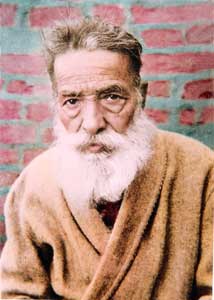
Faqir Chand Ji was Born on November 18, 1886 in village of Panjhal, located in the Hoshiarpur district of Punjab, India. He was brought up in a poor Brahmin family. He had a suppressed childhood. As a result, he sought relief in worship of God. At young age, against his family traditions, he became non-vegetarian for some time. Later, his repentance and prayers took him to Radha Soami Mat through a divine vision of Data Dayal Shiv Brat Lal Ji Maharaj. He initiated Faqir into Radha Soami Mat and gave him a book 'Saar Vachan (सार-वचन)' written by Shiv Dayal Singh (Swami Ji Maharaj) the founder of Radha Soami Mat. He soon found that the book's positions on various religious movements were contrary to his own impressions and beliefs. However, because of his unshakable faith in Data Dayal Ji he took a vow and honestly followed the path shown by his guru. He started delivering discourses (Satsang: सत्संग) to his followers only after Shiv Brat Lal died. Among these discourses was his experienced belief that the images and visions (including holy forms, colors and lines, etc.) that seemed to appear to his followers during meditation were only Maya, or illusions, and did not represent truths as such.
After 1942 Faqir discontinued the traditional practice of Nam-Dan (नाम-दान), (a form of Baptism). Instead, he preached that description of higher stages of inner knowledge by an experienced person was Nam Dan. He performed all the duties of a guru without becoming one. In literature, there is mention of miraculous and divine appearances of his form to the followers in need and distress. But he disassociated himself from all such miracles saying it had happened for the faith of believers and not him. He declared all such followers (सत्संगी) his Satguru (the teller of true knowledge) because their experiences regarding appearing of his holy form compelled him to think as to who helped them while he had no knowledge of those incidents. Those were projections of mind, he concluded. Such experiences facilitated him to go beyond mind (मन), soul (light) (प्रकाश) and inner sound current (शब्द). This lead him to self realization and eternal peace (परम शांति). His craving for ultimate truth ended. In 1980, in view of failing health of Faqir, David C. Lane, professor of Philosophy in California, made him a request to write his autobiography. Faqir accepted and dictated the same to Prof. B.R. Kamal. Originally written in Urdu language, it was translated into English by Prof. Kamal and later edited and published by Dr. Lane.
Baba Faqir Chand died on 11 September 1981 in Pittsburgh, Pennysylvania, North America while touring the United States. Through his will, he established a separate entity for Manavta Mandir, Hoshiarpur, keeping it separate and independent of other Manavta centers. He also made it clear that the trust of Manavta Mandir had no relation other than that of love with Manavta centers (opened in his name) and their preachers within the country and abroad. Faqir allowed his blood relations to serve the temple but prohibited them from becoming members of the trust and interfering with Temple affairs. His mission ('Be Man') was included in his last will. He appointed Munshi Ram Bhagat to give Nam Dan, instruct the souls (जीव) and help distressed and perturbed people. He appointed Dr. I.C. Sharma, a well learned person in spiritual knowledge and practice (परमार्थ और अभ्यास) etc. to work in his (Faqir Chand's place) in absence or presence of Munshi Ram Bhagat. He again appointed Bhagat Munshi Ram to function as Satguru when I.C. Sharma was absent. Under the terms of his will, no fee is to be charged for studying in school run by Manavta Mandir. But, Faqir made it compulsory for parents of wards to give an undertaking which restricted them from giving birth to more than three children (In 1980s it was serious, honest and responsible attempt to include family welfare program in his religion of humanity).
His remains (bones) are interred in the premises of Manavta Mandir with flag of 'Be Man' mission unfurled upon them. He further clarified that his saintism excluded places of veneration of the dead (समाधि), grave, tomb and worship of great people those were dead. Therefore, he kept himself disassociated with 'Shiv Smadh' (tomb of Data Dayal Shiv Brat Lal).